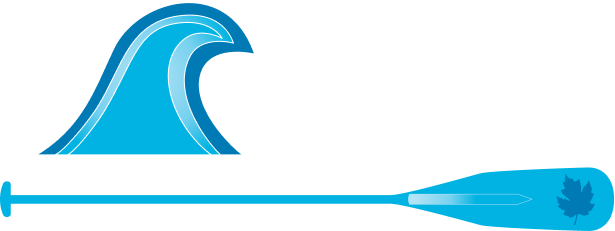A Beginner’s Guide To River Rafting
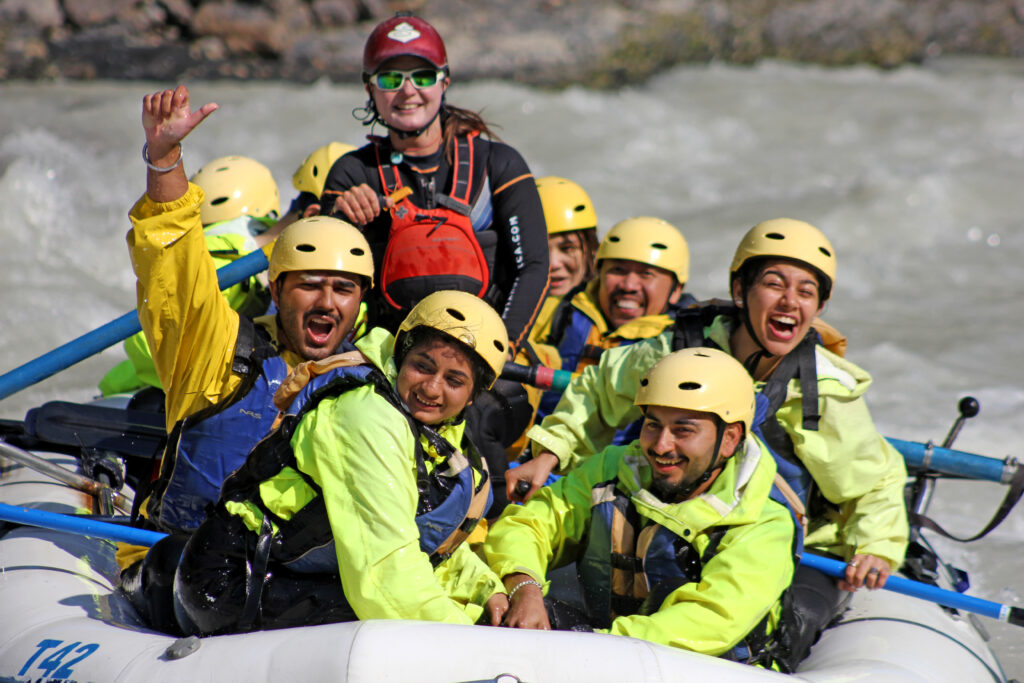
Whitewater rafting is fun, exciting, and exhilarating. It is also a fabulous way to experience wilderness and see spectacular Rocky Mountain scenery from a different perspective. Many of our guests are new to rafting and keen to see what all the hubbub is about. Let’s answer some commonly asked questions in our beginner’s guide to river rafting so to make everyone feel comfortable and knowledgeable about their upcoming Kicking Horse River rafting adventure. Do I need to know how to swim? No. Guests, however, should be comfortable around moving water and be prepared to get splashed (it is river rafting, after all!). In addition to wetsuits, neoprene booties, spray jackets, and helmets, Wild Water Adventures also provides government-approved life jackets. A comprehensive safety briefing is conducted at the river’s edge before rafting begins. Be sure to pay attention to this briefing and to your guide once on the raft. What do I need to bring? Guests need only bring a few items from home: Bathing suit (to wear under the wetsuit) Towel (for changing afterward back at the River Base) How big are the rapids? All trips have Class 2 & 3 waves and rapids. This translates into bouncy and splashy whitewater that spills over the sides of the rafts. For this reason, the Gentle trip makes for a perfect introduction to whitewater rafting with its ‘mild to moderate’ wave action. Our other trips also have Class 4 whitewater. This is the BIG stuff that produces BIG waves. Rafters will definitely get soaked in this kind of whitewater. The half-day Whitewater Exciter, full-length Tradition, and double-run Maximum Horsepower trips all raft the Class 4 ‘wild’ section of the river for which the Kicking Horse is famous. How many people are on a raft? Our rafts hold a maximum of 8 guests, plus a guide. The raft is set up so that the guide sits in the middle, in a rowing position, with 4 guests in front and 4 guests behind. Our rafts are ‘self bailers’ which means when water lands in the raft, it drains away naturally without the need for guests to bail with a bucket. Will I fall out of the raft? Every guide’s mission is to keep all rafters in the raft! Guests who listen to their guide and hold on when told to hold on have a really good chance of staying in the raft for the entire trip. For those statistically minded, of the 10,000 guests, on average, we take rafting each summer, only 30 or so unexpectedly fall out of the raft (because they usually are not holding on). The moral of the story: Listen to your guide and hold on! What happens if I do fall out of the raft? Rafters in the water travel at the exact same speed as the raft itself. They do not get swept away. Anyone who unexpectedly finds themself in the water for a refreshing swim will stay close to the raft and be easily pulled back in by the other rafters. The safety talk at the beginning of the trip explains exactly what to do if such a rare and refreshing event occurs. Can I wear my eye-glasses on the trip? For guests who wear prescription glasses and sunglasses, we do have a supply of safety straps available for sale at the River Base. Or, bring your own to prevent your glasses from falling in the river. Can I bring my camera? No. Cameras and cell phones stay safe (and dry) at the River Base while guests are on the river. Throughout the trip, our crew takes a variety of photographs that will be on display and available for sale afterward. We also have a limited amount of GoPro Hero cameras for rent, or helmets with GoPro mountings for those who wish to bring along their own GoPro camera. Is there anything to eat at the River Base? Yes. Our full-length Tradition automatically includes a gourmet packed lunch served back at the River Base e after the trip. Guests joining us for a morning (8:45 AM) Gentle or Whitewater Exciter departure can upgrade to also enjoy the gourmet BBQ lunch. Hot and cold beverages are always served after every trip and pop, chips, and granola bars are available for sale as well. Where is the River Base? All trips depart from our River Base, conveniently located on TransCanada Highway #1, 45 minutes west of Lake Louise and 20 minutes east of Golden. This is the location where all guests are to arrive at either 8:45 AM or 1:45 PM. For GoogleMap directions, simply click here. Once at the RiverBase, Wild Water Adventures provides transportation to and from the river put-in and take-out locations. Just a short distance from Calgary, we offer the perfect rafting near Calgary experience. For answers to more questions, check out our Frequently Asked Questions page. To chat further about any trip detail or question, please simply call us directly at 1-888-647-6444. See you soon on the river! Author: Deborah Wade
HISTORY OF THE KICKING HORSE RIVER
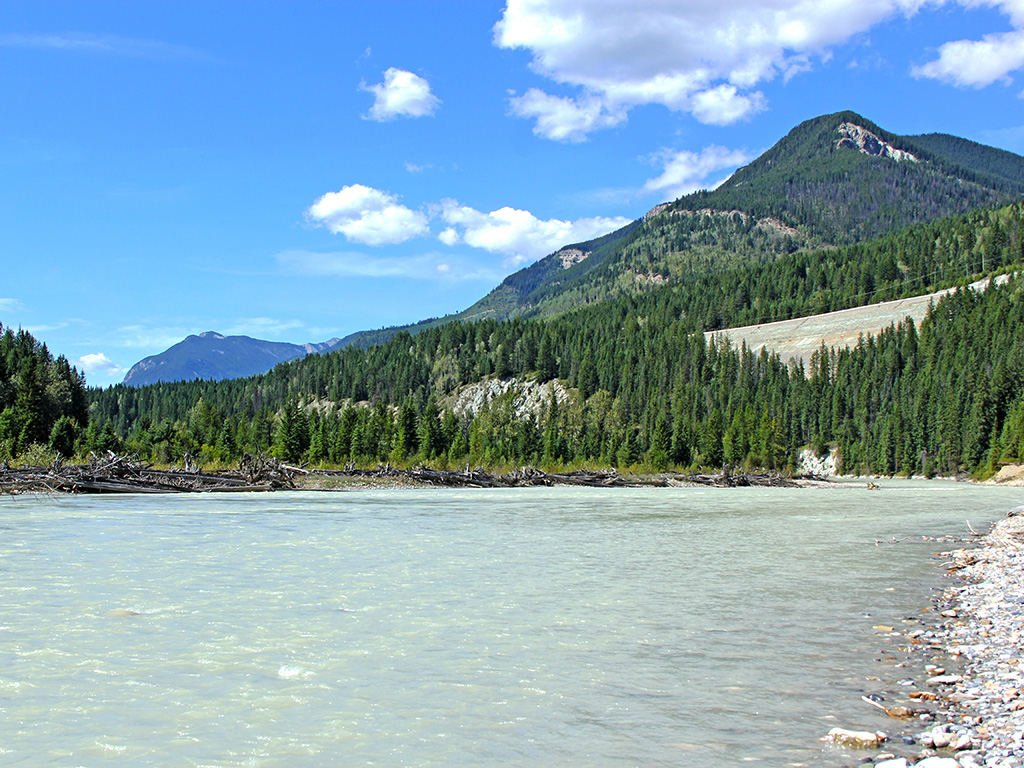
River rafting in British Columbia has a long and well-established history. Companies offering both multi-day wilderness expeditions and action-packed day trips have run guests down a multitude of BC rivers for close to 50 years. The first commercial rafting outfit in British Columbia, in fact, Canada, was Canadian River Expeditions, founded in 1972 by Big John Mikes. CRE specialized (and continues to specialize) in multi-day wilderness rafting expeditions in remote pockets of the province and territories. The first-ever day-tripping company was none other than Kumsheen in 1973, setting up shop on the banks of the Thompson River. This rafting destination remains a popular whitewater escape for those near Vancouver and the Lower Mainland. Kicking Horse River History Closer to the Rockies, near Golden and Lake Louise, the Kicking Horse River and valley has its own cultural and rafting history. Because of the steepness and dramatic elevation changes of the Kicking Horse River, Indigenous Stoney (Nakoda), Piegan and Kootenay (Ktunaxa) tribes chose to seasonally cross the mountains at gentler and more accessible locations. McArthur Pass, near Lake O’Hara, and Lake Minnewanka, near Banff, offered much less challenging routes from one side of the mountains to another. In 1858, the Canadian government announced the building of a railway to connect together eastern and western Canada. The Palliser Expedition was commissioned to locate the best possible route. The obvious choice was Yellowhead Pass, near Jasper. It had the least amount of elevation change through the mountains. The Kicking Horse Pass, historically known by First Nations as Wapta Pass, was not recommended at all. The government, however, decided for two reasons that the treacherously steep Wapta Pass was the best option. It was the shortest route through the mountains (so likely would be the least costly); and, it was the most southern option, closest to the American border. How Did The River Get Its Name? During the Palliser expedition, Dr. James Hector was kicked by his horse and knocked unconscious (see where this is going?). Given the national significance of the expedition’s mission and the doctor’s astounding recovery, both the river and pass were re-named from Wapta to Kicking Horse to commemorate this near-death event. Rafting The Kicking Horse River 100 years or so later, in 1983, the Kicking Horse was rafted for the first time (modern rafting that is, compared to Huckleberry Finn style of rafting). Local whitewater rafters, Linda and Daryl, made the actual first descent proving that certain sections were commercially runnable. About 10 years later, in 1992, Wild Water Adventures popped onto the scene. The river quickly became known for its big whitewater action with Class 2 through Class 4+ waves and rapids. Besides the whitewater, guests also had the chance to see the river just as the early explorers did. With a wild and free-running river and largely untouched wilderness, guests experienced history first hand. Nothing much had changed in the past 150 years. The only new feature was the railway! Over the past 30 seasons, our rafts have run thousands upon thousands of guests down the Kicking Horse River. Many guests, known as Frequent Paddlers, return year after year to experience the true ‘kick’ of this river. Wild Water Adventures extends a heartfelt invitation for enthusiastic guests to step back in time and create their own Kicking Horse history. See you soon on the river!
Best Canada Whitewater Rafting – The Maximum Horsepower Trip
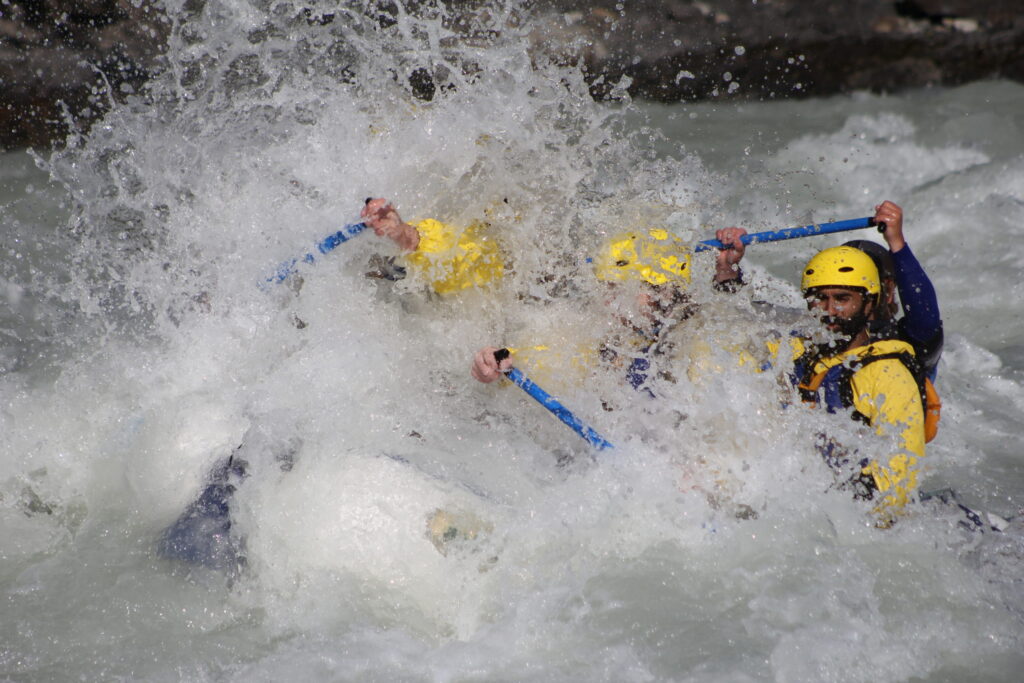
Looking for the biggest and best Calgary rafting adventure with the most whitewater action to be found in the Rockies? Look no further than Wild Water Adventure’s Maximum Horsepower rafting trip on the Kicking Horse River. The MHP, as we like to call this particular trip, definitely lives up to its name. It is not one, but TWO runs down THE best section of whitewater the Kicking Horse River has to offer. Rafters experience 24 exhilarating rapids and cover a total of 24 kilometres of river distance (the longest possible whitewater trip near Banff National Park!) But the adrenaline rush does not stop there. To make this double whitewater trip even more exhilarating, rafters power downstream in two different styles of rafts. The first run, in our ever-popular 16-foot oar-rigged rafts, gives everyone a chance to warm up and get familiar with the river. For the second run, we completely change it up and launch everyone in smaller 14-foot all-paddle rafts with the guide being just another paddler. Believe you me, those two feet make a world of difference! Smaller rafts accentuate everything: the bounces, the smashes, and the hits! It may be the second run on the same section of river, but it will be a completely different experience. Not only that, but everyone (and, I mean everyone) will have a paddle in their hands. 100% participation is required from each and every rafter. There is nothing finer than digging in and paddling hard when your guide hollers out commands. WHO CAN RAFT THE MHP? The MHP is twice the whitewater action of our single-run Whitewater Exciter, and paddling is mandatory on the second run. Because of this, every rafter must be at least 16 years old AND weigh at least 100 pounds. Muscle power, stamina, and enthusiasm for double-action whitewater are key characteristics. WHEN IS THE MHP OFFERED? Smaller boats require the Kicking Horse River to be running at a certain water level. We want to have fun, but more importantly, we want to be safe. If the water level is too high, the smaller boats are not appropriate. The 2022 MHP season kicks off July 20th, pending favourable river levels, and runs through to August 27th. Two weekly departures are offered on Wednesday and Saturday afternoons. Generally by the end of July and into August, the river is at the perfect level for the MHP. WHAT IS PROVIDED FOR RAFTERS? As with all Kicking Horse rafting trips, guests are asked to bring a towel, their own bathing suit/swimming shorts and a heavy polar fleece/polypropelene sweater (for added warmth on the river). In these times of COVID-19, guests are also asked to bring a face covering and ziploc bag (for dry storage of your face covering while on the river). Wild Water provides guests with clean, dry and sanitized wetsuits, wetsuit booties, spray jackets, life jackets, and helmets. Even wetsuit gloves are available (a piece of gear that I personally don’t raft the Kicking Horse River without!). Once back at the RiverBase after the second run, and in dry clothes once again, hot beverages are served and trip photographs displayed. To Find Out More About The MHP, Or Any Of Our Kicking Horse Rafting Adventures, Simply Give Us a Call at 1-888-647-6444. See You On The River! Rafting The Kicking Horse Since 1992 Author: Deborah Wade
River Rafting In The Time of COVID-19
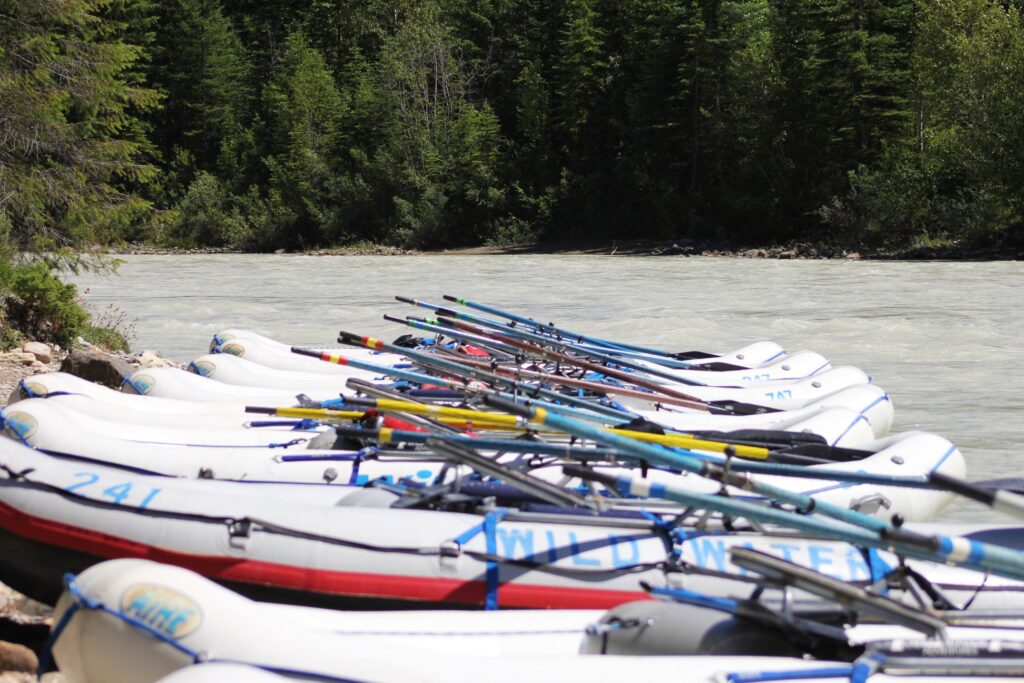
OPENING DAY: SATURDAY, JUNE 27TH! Whitewater rafting on the Kicking Horse River, near Banff National Park, might just be the best outdoor activity to enjoy in the coming months. Once everyone gets the green light to move about more freely in our COVID-19 world, the river will be the place to be. High on everyone’s minds are three critical questions: ‘Where do we go? What do we do? And, is rafting a good activity in the time of COVID-19?’. Question #1: Where Do We Go? Staying relatively close to home, and exploring further into our own provincial backyard, is the message from our health experts. Weeks and weeks of cooped up isolation mean that fun-seeking adventurers are wondering where they can go to play. The Canadian Rockies could not provide a better wilderness setting in which to kick back, relax and blow off some pent up COVID-19 steam. When permitted, hop in your car, truck or RV and road trip out to Banff, Jasper, Kootenay and Yoho National Parks. Long-lasting summer memories can still be made without travelling too far from home. Question #2: What Do We Do? The world may have changed in the past several months, along with how we interact with each other within that world. One aspect, however, that remains steadfast is the importance of spending time in nature and wilderness. River rafting has always offered a grand, naturally wild experience: a chance to deeply breathe in pine-scented air; gaze out at stupendous mountain scenery; and, vigorously shake off cascading water after ploughing through a thrilling set of waves and rapids. Recent articles in the L.A. Times and Men’s Journal reflect on this exact thought. Also worth noting is that the river is already running at a high level, and forecasted to remain so for the season. This summer will be the perfect time to experience the true ‘kick’ in the Kicking Horse River! Returning to the question of ‘what do we do?’, the answer is simple. Let’s go rafting! Question #3: Is Rafting A Wise Activity In The Time of COVID-19? In a word, yes. Public health officials encourage activities that involve being in wide-open spaces. ‘Outdoor rather than indoor’ is the motto when it comes to choosing what to do. For a summer adventure, river rafting could not be better suited to put a smile on a guest’s face while respecting public health advice. Wild Water Adventures adheres strictly to industry safety standards regarding how to raft a river. Provincial guidelines regarding COVID-19 will be met with the same high standard of care. Whether it be at the RiverBase, on our shuttle vehicles, or on the rafts themselves, government safety measures and protocols will be followed to the letter. Exceptions will not be made. Guests gather at the RiverBase, our main hub of activity, before and after the rafting trip. Fortunately, the naturally spacious setting ensures no one needs to feel crowded. Extensive measures will be implemented to uphold both distancing and sanitary requirements. Similar considerations will also come into play while transporting guests to, and from, the river. On the raft itself, guests are already spaced between the bow and stern (or, front and back). Each 16-foot raft holds 8 guests, with 4 in the front, and 4 in the back. The guide sits at the centre of the raft, rowing with the oars. Private raft options are available for intact travelling groups along with fully private departures available for large groups of up to 32 people. Whether on land, in a vehicle, or on a raft, face coverings will be worn, by both guests and crew, if the 2-metre distance cannot be maintained. Guests are required to provide their own face coverings. Rafting gear provided by Wild Water includes wetsuit, wetsuit booties and gloves, spray jacket, life jacket and helmet. Over the past 29 years, it has been our modus operandi to clean, dry and sterilize gear after every single use. With such well-established systems already in place, we are good to go for COVID-19 procedures. For additional warmth, guests are encouraged to pack along their own polar fleece sweater or polypropylene layer. You’ll have that much more fun when warm and happy on the river! WHEN CAN WE RAFT? Opening day on the river is SATURDAY, JUNE 27th! The entire crew at Wild Water Adventures wishes to reassure each and every guest that your health and safety remain our Number 1 priority. That is the way it has always been and will continue to be. Adjusting our current safety-conscious operations to incorporate COVID-19 health measures requires only minor tweaking. We are, essentially, ready to ‘rock and raft’. To chat about summer possibilities, simply give us a call at 1-888-647-6444. We do look forward to seeing everyone on the river. Remember to bring your bathing suit, towel and face coverings! Author: Deborah Wade
